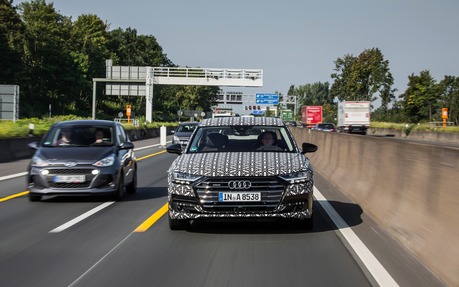2019 Audi A8: The Audi that Drives Itself in Traffic
Düsseldorf, Germany– Traffic Jam Pilot is the name Audi has given the system that allows the A8 to drive itself fully autonomously in – you guessed it – traffic jams.
I’m on board the new 2019 Audi A8 with Daniel Lepczyk, an autonomous driving systems development engineer at Audi. We’re inching along in one of the numerous traffic jams that take place daily at rush hour in North Rhine, where nearly 8 million people live and where severalautobahnenconverge. It’s the very same phenomenon that plays out at home and elsewhere in the world – cars and trucks crawl along, then stop, only to start again after a delay of anywhere from a few seconds to almost a half a minute.
- Also: Audi shows off six-door, 20-ft long A8 L extended
- Also: Audi Aicon: A Level 5 Autonomous Concept
Instead of cursing our current predicament, we watch the news play on the A8’s central screen while the car navigates the jam on its own. It stays the course, advancing and stopping fluidly, as though driven by a very experienced driver who takes great care to ensure passenger comfort.
Sayauf Wiedersehento stress
Lepczyk explains to me that we could just as easily read or send e-mails, surf the Web or even check our agendas, still by way of the central screen, provided our mobile phones are connected to the car using Bluetooth.
Totally free of the sometimes stressful task of controlling the A8 in heavy traffic, the driver can tend to other matters. Your help is not required to stop or start the car, which stays in the middle of its lane when the flow of traffic is faster, but automatically edges closer to one of the sides before stopping in order to create space between the two lanes. This could be handy if an emergency vehicle needs to get to the scene of the accident that’s causing the back-up. This is the immediate future of autonomous driving.
Essential prerequisites
Thus, the 2019 Audi A8 becomes the first production vehicle capable of level-3 autonomy. But this kind of independence is only possible in very specific conditions. For starters, the car must travel on a highway that has clearly identified lanes as well as a physical separation (like a low wall or a guardrail) between the two directions of traffic. Also, the speed mustn’t exceed 60 km/h.
So, Traffic Jam Pilot isn’t helpful in an urban environment, where there are pedestrians and cyclists, nor does it work on secondary roads. It’s only functional on the highway, and only at low speed. But when the conditions are right, all the driver has to do is press the AI (Audi Intelligence) button located on the central console. This engages the system and displays a visual on the virtual cockpit screen, letting you know that Traffic Jam Pilot is now in control of the A8.
Tech talk
Traffic Jam Pilot is a very elaborate system that uses 12 sensors situated in the front, the back and on the sides of the car, four 360-degree cameras placed in front, in back and on the side mirrors, a front camera located at the top of the windshield, four mid-range radars installed (one in each of the four corners of the car), a front-mounted long-range radar, an Li-DAR laser detector and a camera integrated into the dashboard that’s angled toward the driver to make sure he or she is alert.
All these sensors, cameras and radars forward their data to the central controller that Audi calls zFAS, which is housed under the driver’s seat. On its own, it’s more powerful than all the other systems integrated into the previous-generation Audi A8. It helps create the 360-degree portrait of the car’s external environment.
Audi’s engineers also made sure that all the systems are backed up. In other words, if the camera can’t “see” through the fog, the radars can. If the antilock device that controls braking when autonomous mode is engaged fails, an electric motor puts pressure on the back pedal. If the zFAS controller fails, the long-range radar in front takes over.

On the road again
When the flow of traffic exceeds 60 km/h, Traffic Jam Pilot alerts the driver that he or she needs to take control of the vehicle. At first, the sides of the virtual cockpit and the AI symbol turn red and a signal sounds. From this point onward, the driver has 10 seconds to take the wheel.
If the driver fails to do so, phase 2 kicks in, slowing the A8 down progressively, then braking hard three times while simultaneously tightening the driver’s seat belt three times as well. If the driver still doesn’t intervene, perhaps due to sudden loss of consciousness, the system orders the car to stop completely, activates the hazard lights, unlocks the doors and makes an emergency call to allow first responders to locate the vehicle.
Legal fine print
Audi’s Traffic Jam Pilot is the definition of level-3 autonomous driving, in that the car completely takes over from the driver under specific conditions. And Audi confirms that the brand will take complete responsibility in case of an accident. For the time being, level-2 autonomy, which is semi-autonomous driving with adaptive cruise control and lane-centering as long as the driver touches the wheel every 10 seconds, is legal only in Germany and Florida.
The brand’s upper management hopes that laws will progress along with their technological advances. But since it has to comply with the various laws in effect in each country and region, distribution of Traffic Jam Pilot will initially be limited. They expect it to become more widespread in the future, once the legal side catches up to the technology.
